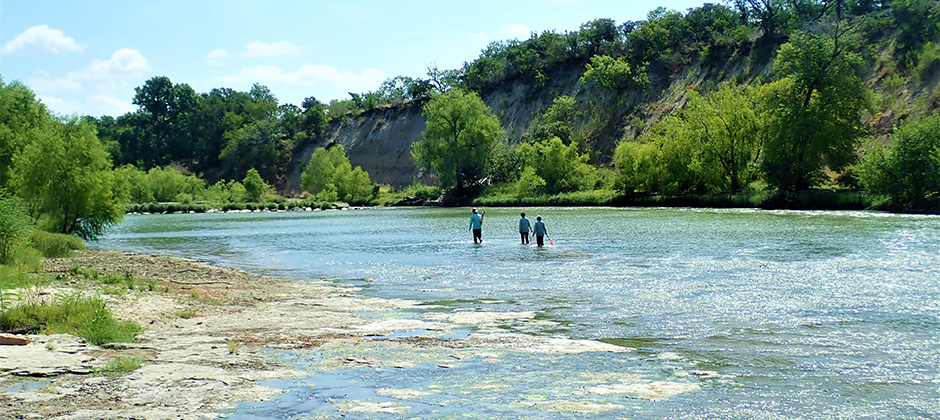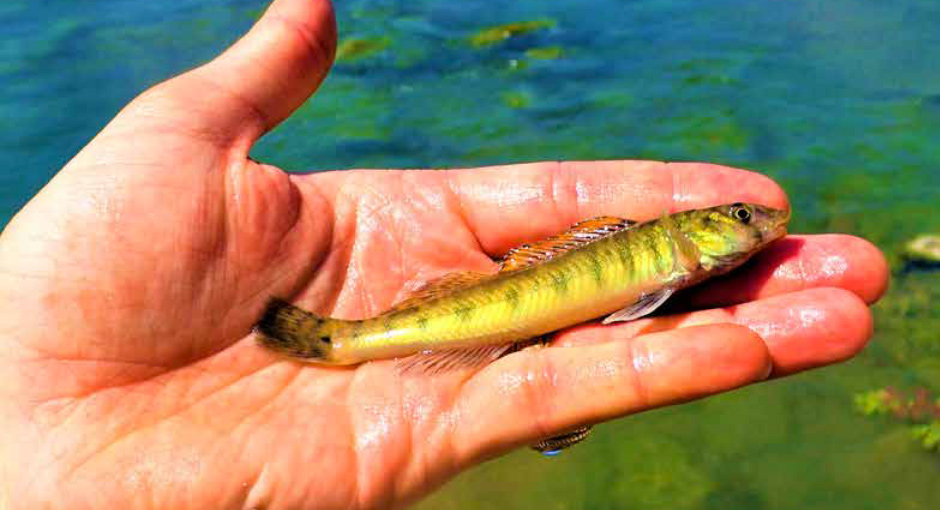While all the metrics in the San Antonio River Basin Report Card have overlapping correlation to the safe, clean, enjoyable creeks and rivers aspects of the River Authority’s mission, the Habitat Quality Index grade is primarily related to the clean aspect.
One of the main functions of a habitat assessment is to characterize the aquatic- and riparian-life potential of a creek or river. The Habitat Quality Index (HQI) is a requirement of all bioassessment activities in Texas per the Texas Commission on Environmental Quality’s (TCEQ) Surface Water Quality Monitoring (SWQM) Procedures, Volume 2. The HQI provides quantifiable, reproducible data reported to the TCEQ.
The HQI has primary, secondary, and tertiary attributes. Primary attributes include bottom substrate stability, dimensions of largest pool, and available instream cover. Secondary attributes include number of riffles, channel flow status, and channel sinuosity. Tertiary attributes include bank stability, riparian buffer vegetation, and aesthetics of reach. Scores for each of the HQI attributes are scored and added up. That total value is then rated as exceptional, high, intermediate, or limited based on ranges established by TCEQ.

Grade for 2022:
B-
How is this being measured?
To determine the Habitat Quality Index (HQI), we examined the last three years of data for each of the 17 sites in the San Antonio River Basin monitored by the River Authority. Last year these metrics were calculated based on 20 sites. These measurements are done on a 3-year rolling average, and three sites that were assessed last year did not have data for the updated 3-year time frame. The River Authority adds or drops monitoring stations for a myriad reasons including special studies based on watershed conditions starting or stopping, a more representative site is found within a waterbody, or site accessibility issues.
The grade is calculated by taking the number of sites meeting the designated use divided by the total number of sites monitored, multiplied by 100. Therefore, the grade for this metric is based on the percentage of monitored sites that meet the designated use.
Explanation of the Grade
There were 11 of 17 sites meeting the designated use:
11 / 17 * 100 = 64.7%
Grade: B-
Key Findings
The HQI grade indicates that the San Antonio River Basin has a relatively high potential for aquatic life, and thus, a relatively high potential for maintaining biodiversity and species richness. The HQI score does indicate that improvements can still be made to further enhance the potential of the basin to support even more richly diverse and healthy aquatic and riparian populations.
Recommended Actions
The recommended actions to improve the HQI grade share some similarities with the recommendations to improve the Index of Biotic Integrity score measured in this Basin Report Card. The first recommended action is for residents of the San Antonio River Basin to learn more about the general health of the creeks, rivers, and riparian corridors that make up the basin. The data and an explanation of the findings can be found in the San Antonio River Basin Summary Report and the Basin Highlight Reports.
The San Antonio River Basin Summary Report, which is completed every five years, provides an overview of monitoring and assessment activities in the San Antonio River Basin, as well as a deep dive into the environmental monitoring data collected by the River Authority. The 2018 report was prepared by River Authority staff in coordination with the Texas Commission on Environmental Quality (TCEQ) and in accordance with the state’s guidelines. The report presents a 10-year history of the levels of bacteria, nutrients, aquatic life use, and other water quality parameters at more than 180 sites throughout six watersheds in the basin, covering various periods. The 2023 Basin Summary Report will be available in June 2023.

The Basin Highlight Reports provide annual updates of the findings and activities conducted by the River Authority for the San Antonio River Basin in cooperation with the TCEQ under the State of Texas Clean Rivers Program (CRP). The 2022 report includes an overview of basin water quality monitoring activities; a review of water quality data; a discussion of activities and findings for special studies; maps showing the location of sampling sites; a discussion of participation of other organizations in the basin monitoring program; and public outreach activities.
Learn more about the State of Texas Clean Rivers Program.
Other actions citizens can take is to sign the pledge to reduce litter through proper disposal of waste as well as recycle and reuse materials when possible; plant native vegetation at your home and business and promote use of native vegetation throughout your community; and reduce bacteria and other pollutants by implementing and supporting the use of green infrastructure, which are types of multi-benefit best management practices that help reduce flooding and improve water quality in area creeks and rivers.
Grade for 2021:
B
How is this being measured?
To determine the Habitat Quality Index (HQI), we examined the last five years of data for each of the 20 sites in the San Antonio River Basin monitored by the River Authority. Last year these metrics were calculated based on 21 sites. These measurements are done on a 3-year rolling average, and one site that was assessed last year did not have data for the updated 3-year time frame.
The grade is calculated by taking the number of sites meeting the designated use divided by total number of sites monitored, multiplied by 100. Therefore, the grade for this metric is based on the percentage of monitored sites that meet the designated use.
Explanation of the Grade
There are 14 of 20 sites meeting the designated use:
Grade: B
(14 / 20 * 100 = 70.0%)
Key Findings
The HQI grade indicates that the San Antonio River Basin has a relatively high potential for aquatic and riparian life, and thus, a relatively high potential for maintaining biodiversity and species richness. The HQI score does indicate that improvements can still be made to further enhance the potential of the basin to support an even more richly diverse and healthy aquatic and riparian populations.
Recommended Actions
The recommended actions to improve the HQI grade share some similarities with the recommendations to improve the Index of Biotic Integrity score measured in this basin report card. The first recommended action is for residents of the San Antonio River Basin to learn more about the general health of the creeks, rivers, and riparian corridors that make up the basin. The data and an explanation of the findings can be found in the San Antonio River Basin Summary Report and the Basin Highlights Report.
The San Antonio River Basin Summary Report, which is completed every five years, provides an overview of monitoring and assessment activities in the San Antonio River Basin. The 2018 report was prepared by River Authority staff in coordination with the Texas Commission on Environmental Quality (TCEQ) and in accordance with the state’s guidelines. The report presents a 10-year history of the levels of bacteria, nutrients, aquatic life use, and other water quality parameters at more than 180 sites throughout six watersheds in the basin, covering various periods.

The Basin Highlights Report provides annual updates of the findings and activities conducted by the River Authority for the San Antonio River Basin in cooperation with the TCEQ under the State of Texas Clean Rivers Program (CRP). The 2021 report includes an overview of basin water quality monitoring activities; a review of water quality data; a discussion of activities and findings for special studies; maps showing the location of sampling sites; a discussion of participation of other organizations in the basin monitoring program; and public outreach activities.
Learn more about the State of Texas Clean Rivers Program.
Other actions citizens can take is to sign the pledge to reduce litter through proper disposal of waste as well as recycle and reuse materials when possible; plant native vegetation at your home and business and promote use of native vegetation throughout your community; and reduce bacteria and other pollutants by implementing and supporting the use of green infrastructure, which are types of multi-benefit best management practices that help reduce flooding and improve water quality in area creeks and rivers.
Grade for 2020:
B+
How is this being measured?
To determine the Habitat Quality Index (HQI), we examined the last five years of data for each of the 21 sites in the San Antonio River Basin monitored by the River Authority. The grade is calculated by taking the number of sites meeting the designated use divided by total number of sites monitored, multiplied by 100. Therefore, the grade for this metric is based on the percentage of monitored sites that meet the designated use.
Explanation of the Grade
There are 16 of 21 sites meeting the designated use:
Grade: B
(16 / 21 * 100 = 76.2%)
Key Findings
The HQI grade indicates that the San Antonio River Basin has a relatively high potential for aquatic and riparian life, and thus, a relatively high potential for maintaining biodiversity and species richness. The HQI score does indicate that improvements can still be made to further enhance the potential of the basin to support an even more richly diverse and healthy aquatic and riparian populations.
Recommended Actions
The recommended actions to improve the HQI grade share some similarities with the recommendations to improve the Index of Biotic Integrity score measured in this basin report card. The first recommended action is for residents of the San Antonio River Basin to learn more about the general health of the creeks, rivers, and riparian corridors that make up the basin. The data and an explanation of the findings can be found in the San Antonio River Basin Summary Report and the Basin Highlights Report.
The San Antonio River Basin Summary Report, which is completed every five years, provides an overview of monitoring and assessment activities in the San Antonio River Basin. The 2018 report was prepared by River Authority staff in coordination with the Texas Commission on Environmental Quality (TCEQ) and in accordance with the state’s guidelines. The report presents a 10-year history of the levels of bacteria, nutrients, aquatic life use, and other water quality parameters at more than 180 sites throughout six watersheds in the basin, covering various periods.

The Basin Highlights Report provides annual updates of the findings and activities conducted by the River Authority for the San Antonio River Basin in cooperation with the TCEQ under the State of Texas Clean Rivers Program (CRP). The 2020 report includes an overview of basin water quality monitoring activities; a review of water quality data; a discussion of activities and findings for special studies; maps showing the location of sampling sites; a discussion of participation of other organizations in the basin monitoring program; and public outreach activities.
Learn more about the State of Texas Clean Rivers Program.
Other actions citizens can take is reduce litter through proper disposal of waste as well as recycle and reuse materials when possible; plant native vegetation at your home and business and promote use of native vegetation throughout your community; and reduce bacteria and other pollutants by implementing and supporting the use of green infrastructure.

